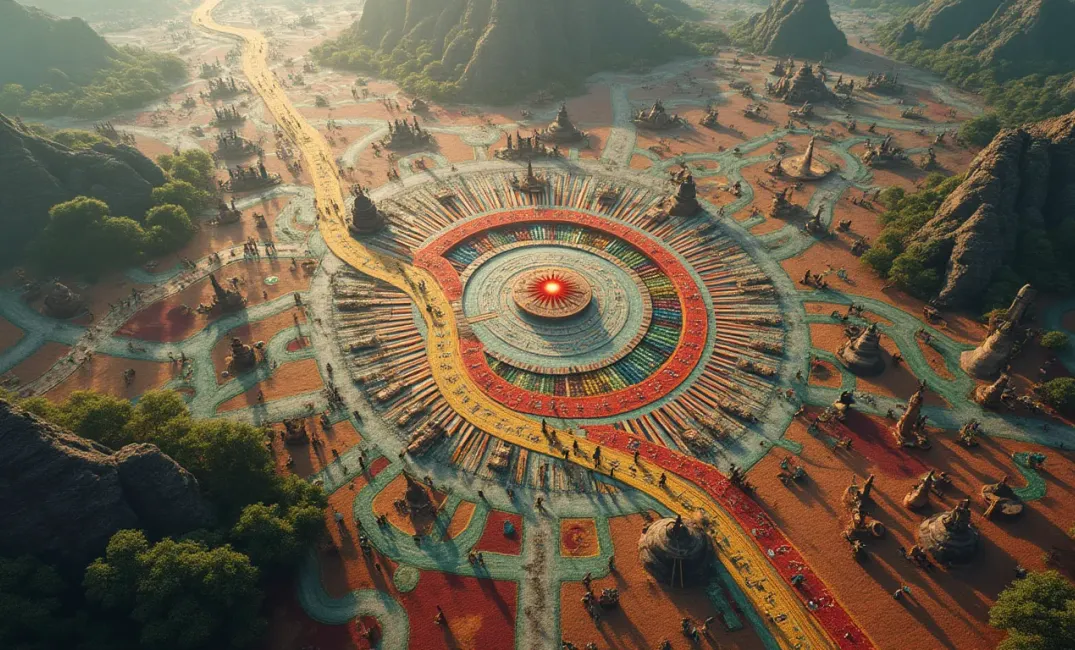Introduction: The Tapestry of Societal Evolution
"Society does not consist of individuals but expresses the sum of interrelations, the relations within which these individuals stand." — Karl Marx
Throughout history, human society has evolved from small tribal communities to sprawling global networks. This transition has been driven by necessity, innovation, and the relentless pursuit of improvement. As individual threads woven into a complex tapestry, societal evolution reflects the shared and divergent paths that have defined human civilization. In this entry, we examine the chronicles of societal growth, highlighting the mechanisms, milestones, and metaphors of human unity and diversity.
From Tribes to Kingdoms: Foundations of Human Society
The Dawn of Societal Structures
- Nomadic Bands and Early Tribes: In the earliest stages of human existence, small, nomadic bands roamed prehistoric landscapes, relying on kinship and cooperation for survival. These early societies often followed the migratory patterns of game, evolving complex cultural rituals and belief systems within their mobile lifestyle.
- Tribal Societies: Clan and Community: As communities settled, tribal societies began to form, often based on kinship ties, a shared language, and cultural traditions. Leadership emerged organically, with elders and chieftains guiding collective decisions and conflicts settled through customary laws and negotiation.
Emergence of Complex Societies
- The Agricultural Revolution and Sedentarization: The development of agriculture allowed humans to settle in one place, fostering the growth of larger, more complex societies. Permanent settlements led to the development of urban centers, economies of trade and surplus exchange, and the advent of social stratification.
- City-States and Early Kingdoms: The formation of city-states represented a pivotal shift toward centralized authority. Notable examples include Mesopotamia's Sumerian cities and the Greek polis. Kingdoms began to consolidate power over larger territories, laying the groundwork for expansive empire-building.
Empires and Nations: Growth and Unification
The Rise and Fall of Empires
- Imperial Expansion and Administration: Empires such as Rome, Persia, and China expanded across vast territories, unified under a central authority. They implemented sophisticated administrative systems, infrastructure, and legal frameworks to maintain order and foster trade and cultural exchange.
- Cultural Syncretism and Imperial Legacy: The growth of empires facilitated cultural syncretism, wherein conquered and allied peoples exchanged religious practices, art, language, and technology, enriching societies and laying a foundation for future cultural movements.
Nations and the Concept of Statehood
- Birth of the Nation-State: In modern history, the nation-state emerged, defining political boundaries and fostering a collective identity among citizens bound by a shared language, history, and cultural practices. This new structure sought to balance autonomy with participation in the broader global community.
- Nationalism and Global Consciousness: The rise of nationalism highlighted both the aspirations and tensions of maintaining distinct identities within a global context. As global connections deepened, societies questioned the role of the nation-state in a world responding to shared challenges such as climate change and economic globalization.
Societal Mechanisms: Cohesion and Transformation
Mechanisms of Integration and Diversity
- Social Hierarchies and Class Systems: Human societies have often organized into hierarchical structures based on social class, occupation, and ethnicity. While these divisions can foster social cohesion, they also perpetuate inequality and conflict, driving societal reform and revolutions.
- Cultural Pluralism and Multicultural Societies: The migration of peoples and the exchange of cultural ideas contributed to increasingly multicultural societies. Successful integration and the celebration of cultural diversity require social frameworks that promote inclusion, tolerance, and dialogue.
Innovations in Social Structuring
- Technological Advancements and Societal Change: Technology has continually reshaped societal structures, from the industrial innovations that fueled urbanization to digital communication shaping the modern landscape. These advancements offer new opportunities and ethical challenges, altering the social fabric with each technological leap.
- Education and the Empowerment of Societies: As an evolving societal mechanism, education remains vital for equipping societies to navigate global challenges. By fostering critical thinking, innovation, and cultural literacy, education empowers individuals and communities to adapt to changing social needs.
Global Networks: The Tides of Interconnectedness
Communication and Connectivity
- The Rise of Global Communication: The dawn of the digital age has transformed communication, connecting distant societies in real-time and enabling rapid knowledge exchange. This global communication network facilitates collaborative problem-solving and cultural exchange, empowering grassroots movements and political activism.
- Media and Cultural Exchange: From the print media explosion to the rise of social media, communication technologies have significantly impacted cultural narratives, public discourse, and the perception of identity. The influence of media often shapes societal values, aspirations, and conflicts.
International Cooperation and Global Governance
- Institutions and International Law: Entities such as the United Nations and the World Trade Organization represent efforts to foster international cooperation, establishing legal frameworks to manage global conflicts, trade, development, and environmental sustainability.
- Global Challenges and Collective Action: Issues such as climate change, pandemics, and inequality require global collaboration and awareness. Societies that prioritize shared responsibility and coordinated action can navigate these challenges, fostering clearer pathways to global resilience, stability, and sustainability.
Societal Tensions: Navigating Divergence and Unity
Conflicts and Social Movements
- Protests, Revolutions, and Change: Throughout history, social unrest and revolutions have been catalysts for significant societal transformation. Movements demanding equality, justice, and reform underscore the dynamic tensions within society's continual evolution.
- The Quest for Equality: Efforts to address historical inequities and power imbalances remain at the forefront of societal challenges. Societies are leveraging mechanisms such as legislation, societal activism, and education to build a more equitable and inclusive environment for all.
Balancing Individual and Collective Needs
- Economic Systems and Their Impact: Diverse economic models—ranging from capitalism to socialism—reflect different approaches to balancing individual ambitions with collective welfare. Societal debates continue to explore the efficacy and fairness of these systems in achieving prosperity and stability.
- Identity, Diversity, and Social Integration: Modern societies grapple with reconciling diverse individual identities with collective goals. Structured dialogue and action aimed at fostering solidarity and mutual respect are crucial in building societies where both unity and diversity thrive harmoniously.
Conclusion: Humanity's Collective Tapestry
"The whole is greater than the sum of its parts." — Aristotle
The evolution of human society weaves a vibrant tapestry, reflecting the shared aspirations and unique paths that define our existence. As societies grow more interconnected through technology and innovation, the tapestry's threads become both more intricate and resilient.
Within this network, humanity's potential for empathy, collective problem-solving, and cooperation offers hope for navigating future complexities. By embracing our interconnected heritage while fostering diverse identities and common goals, we can shape a future that honors the kaleidoscope of human experience and aspiration.
As the guardians of tomorrow, humanity's narrative continues to be written with threads from every corner of the globe, capturing the spirit of an indomitable, ever-evolving collective endeavor. Through unity and diversity, the tapestry of human society unfolds, offering insight, resilience, and inspiration as we journey toward a future yet known.
GLOBAL NETWORKS, INTEGRATION, EVOLUTION, INNOVATION, HUMAN CIVILIZATION, COMMUNICATION, SOCIETY, DIVERSITY, TRIBES

